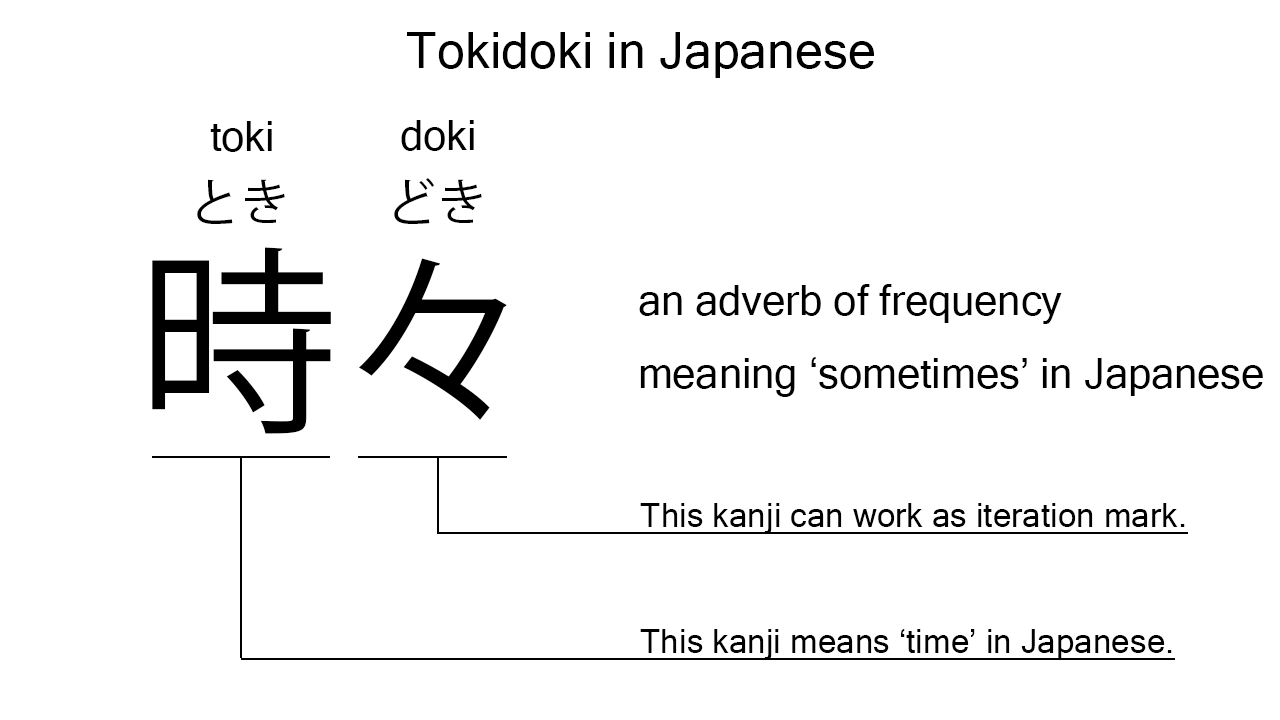What does “tokidoki” mean in Japanese?
Native speakers use tokidoki often to mean ‘sometimes’ in Japanese. Perhaps, some Japanese learners know this word as it is sometimes used in Japanese conversations. In this blog post, however, I’m explaining this word in detail based on its kanji expression. And also, I’m explaining how to use it through example sentences. My explanations would help Japanese learners understand tokidoki more clearly. Then, let’s get started!
Contents
Definition and meanings of “tokidoki”
Let me start with the definition and meanings of tokidoki.
- tokidoki – 時々 (ときどき) : an adverb of frequency used to mean ‘sometimes’ or ‘from time to time’ in Japanese.
The definition and meanings are simple and clear, I think. To understand this adverb more clearly, however, let me explain its kanji characters in detail, one by one.
Tokidoki in kanji
The kanji expression of tokidoki consists of the following two kanji characters:
- 時 : a kanji character used to mean ‘time’ in Japanese.
- 々 : a kanji character used to avoid repeating the same kanji. So, this kanji works as an iteration mark in kanji expressions.
From these two kanji characters, we can understand that tokidoki literally means ‘time time’ in Japanese. Interestingly, this kanji concept is a bit similar to that of the English phrase, from time to time.

When we meet new kanji expressions, we should check their kanji characters in detail to understand their meanings clearly and deeply. In many cases, kanji characters tell us a lot about the meanings of the expressions they form. Actually, here, we could get the better understanding of tokidoki through the detailed kanji check above.
So far, I’ve explained the definition and meanings of tokidoki together with its kanji characters. Then, let me explain how to use it through the example sentences below.
How to say “sometimes” in Japanese
watashi tachi wa tokidoki jimu ni iki masu – 私達は時々ジムに行きます (わたしたちはときどきじむにいきます)
We sometimes go to a gym.
Below are the new words used in the example sentence.
- watashi – 私 (わたし) : a pronoun meaning ‘I’ in Japanese.
- tachi – 達 (たち) : a suffix used after a noun or pronoun to make its plural form. In the example, this is used after watashi to make its plural form, watashi tachi, which means ‘we’ in Japanese. Learn more about Japanese plural.
- wa – は : a binding particle working as a case marker or topic marker. In the example, this works after watashi tachi to make the subject in the sentence.
- jimu – ジム (じむ) : a noun meaning ‘gym’ in Japanese. This is an imported word.
- ni – に : a case particle used to say where someone or something goes. In the example, this is used after jimu to say where the speakers sometimes go.
- iki – 行き (いき) : one conjugation of the verb, iku, which means ‘to go’ in Japanese. In the example, it has been conjugated for the better connection with its following word.
- masu – ます : an auxiliary verb used after a verb to make it polite. Probably, this is well known as a part of Japanese masu form. In the example, this is used after iki to make it sound polite.
This is a typical usage of tokidoki. It is an adverb, so can work almost anywhere in a sentence. In the example, it works in the middle of the sentence to mean ‘sometimes’ in Japanese.
Another example of “tokidoki”
tokidoki kanojo no eigo ga wakara nai – 時々彼女の英語が分からない (ときどきかのじょのえいごがわからない)
Sometimes, I can’t understand her English.
Below are new words used in the example sentence.
- kanojo – 彼女 (かのじょ) : a pronoun meaning ‘she’ in Japanese.
- no – の : a case particle used after a noun or pronoun to make its possessive case. In the example, this is used after kanojo to make its possessive case, kanojo no, which means ‘her’ in Japanese.
- eigo – 英語 (えいご) : a noun meaning ‘English’ or ‘the English language’ in Japanese.
- ga – が : a case particle used to make the subject word or the object word in a sentence. In the example, this is used after the noun phrase, kanojo no eigo, to make the object in the sentence.
- wakara – 分から (わから) : one conjugation of the verb, wakaru, which means ‘to see’ or ‘to understand’ in Japanese. In this example, it has been conjugated for the better connection with its following word.
- nai – ない : an auxiliary verb used after a verb, adjective, or auxiliary verb to deny its meaning. In the example, this is used after wakara to deny its meaning. Word orders in Japanese and English are different, but the role of this auxiliary verb is similar to that of not.
This is another example of tokidoki. In this example, it works at the beginning of the sentence to mean ‘sometimes’ in Japanese. When we want to mean ‘sometimes’ in Japanese, anyway, this adverb is always a very good option.
Summary
In this blog post, I’ve explained the definition and meanings of tokidoki in detail based on its kanji expression. And also, I’ve explained how to use it through the example sentences. Let me summarize them as follows.
- tokidoki – 時々 (ときどき) : an adverb of frequency used to mean ‘sometimes’ or ‘from time to time’ in Japanese. These two kanji characters literally mean ‘time time’ in Japanese. Interestingly, this kanji concept is a bit similar to that of the English phrase, from time to time. Both languages have a similar idea on how to express the frequency.
Hope my explanations are understandable and helpful for Japanese learners.
Leave a Reply